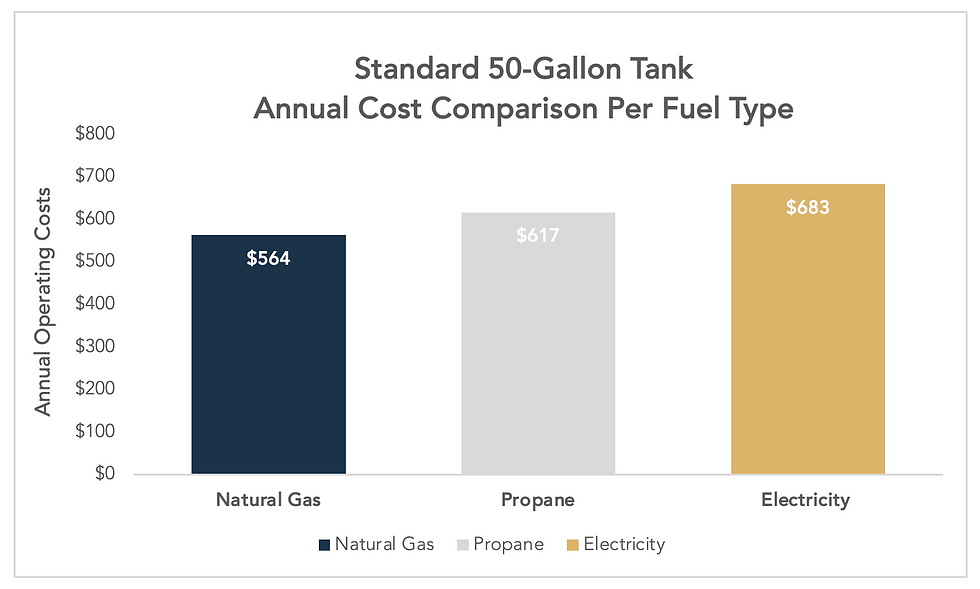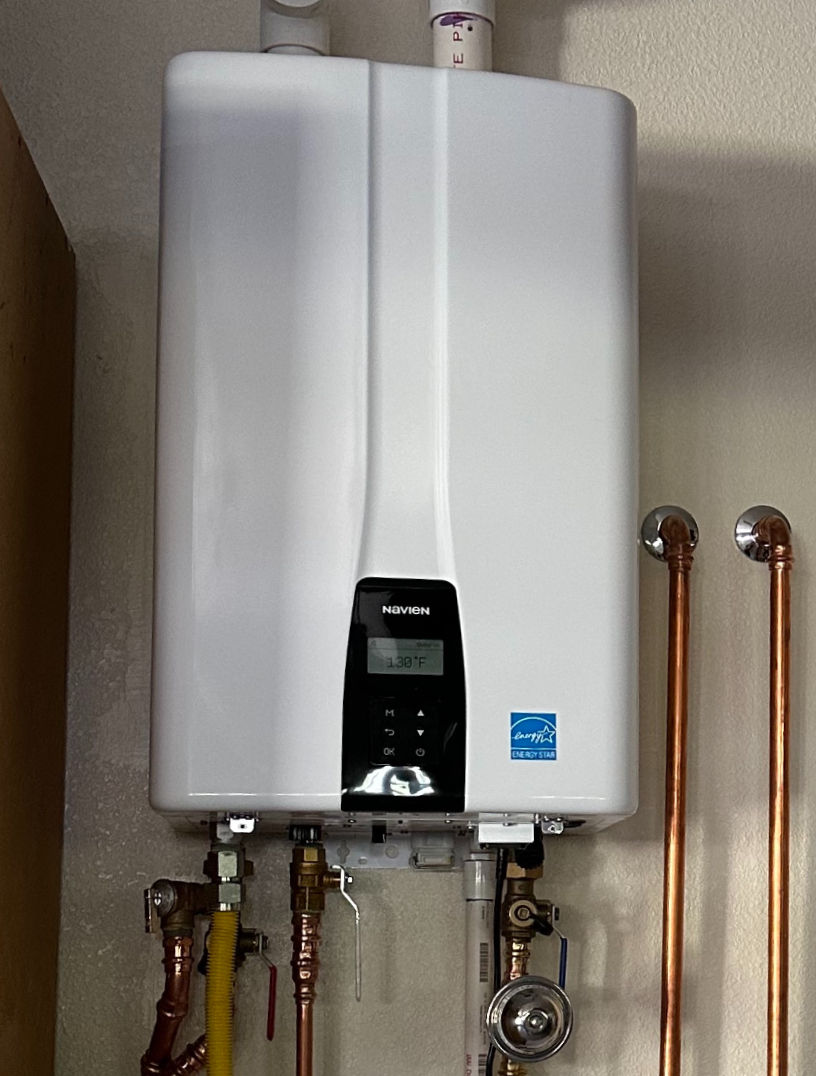Tank vs. Tankless: What You Need to Know for Your Next Water Heater Installation
- STL-HD Construction & Design
- Aug 17, 2024
- 6 min read
Updated: Aug 17, 2024
When it’s time to replace your water heater or install a new one, you’re faced with a crucial decision: Should you go with a traditional tank water heater or a modern tankless system? Both have their advantages and potential drawbacks, so understanding the differences between them is key to making the best choice for your home.

Tank Water Heaters: The Traditional Workhorse
Tank water heaters are the most common type of water heaters found in existing homes today. They consist of a large tank that stores a specific amount of hot water, usually ranging from 30 to 75 gallons. When you turn on your hot water tap, the heated water from the tank flows out, while cold water fills the tank to be heated for future use.
When considering a new tank water heater, understanding the annual operating costs of different fuel types is essential for making an informed decision. Each type of fuel has its own cost dynamics, influenced by factors like energy prices, and efficiency ratings.


Pros: | Cons: |
Lower Initial Cost: Tank water heaters are typically less expensive to purchase and install compared to tankless systems. | Limited Hot Water Supply: Once the tank’s hot water is depleted, you’ll have to wait for it to refill and reheat. |
Simplicity: Provides hot water even during outages (if using gas). | Higher Energy Costs: Tank heaters continuously use energy to keep water hot, even when not in use, leading to higher utility bills. |
Type of Fuel: Natural gas, propane, and electricity are common for tank systems. Gas models tend to be more energy-efficient than electric ones when comparing between fuel types among tank systems only. | Space Requirements: The bulky tank takes up significant space, which could be a challenge in smaller homes or apartments. Not designed to be exposed to the outside elements requires to be sheltered (ex: garage, interior closet, or exterior accessible closet). |
Lifespan: Average 8 to 12 years. Tank water heaters are more susceptible to corrosion and sediment buildup over time, especially if the tank isn’t maintained properly. Regular flushing and anode rod replacement can extend its life, but eventually, the constant heating and cooling cycles, as well as the potential for leaks, will lead to its replacement. | |
Warranty: Ranges from 6 to 12 years, depending on tank purchased. |

Tankless Water Heaters: The On-Demand Solution
Tankless water heaters, also known as on-demand water heaters, heat water only when you need it. Instead of storing hot water, they use high-powered burners or electric coils to instantly heat water as it passes through the unit.
When considering a new tankless water heater, understanding the annual operating costs of different fuel types is essential for making an informed decision. Each type of fuel has its own cost dynamics, influenced by factors like energy prices, and efficiency ratings.


Pros: | Cons: |
Energy Efficiency: Tankless systems only use energy when hot water is needed, which can lead to significant savings on your utility bills. | Higher Initial Cost: Tankless water heaters are more expensive to purchase and install, though they often pay for themselves over time with energy savings. |
Endless Hot Water: Since water is heated on demand, you won’t run out of hot water—even during extended use. For larger homes with more bathrooms larger tankless models are available with a built in recirculation pump eliminating questioning instant hot water supply demands. | Upgrades: Installing a tankless system from a tank system may require to upgrade or reconfigure your gas lines, water lines, vent lines, and add an electrical line to power the system. Adding to the cost of installation. |
Space-Saving Design: Without a bulky tank, tankless units take up much less space and can be installed in various locations. | Complexity: They are gas heated and powered by an electrical 120v outlet, they do not function during a power outage leading to cold water during an outage. |
Interior/ Exterior Installation Options: Exterior Tankless Models available to purchase and install for exterior application. | |
Lifespan: Average 20 to 25 years. Tankless water heaters generally last much longer because they don’t store water, which eliminates the risk of corrosion and sediment buildup. Maintenance is still necessary, such as descaling to prevent mineral buildup, especially in areas with hard water. With proper care, tankless systems can last more than twice as long as traditional tank heaters. | |
Warranty: 15 years on most tankless units. A longer warranty often indicates a better-quality product. |
Which Is Right for You?
Choosing between a tank and tankless water heater depends on your specific needs, budget, and lifestyle.
For Small Households: If you live alone or your household size is between 2 to 3 with 1 to 2 bathrooms, a tank system might be the perfect fit. It's cost effective and budget friendly to install.
For Larger Households: If you have a large family or multiple bathrooms, a tankless water heater might be more practical, as it can handle hot water demands more reliably, you may need a larger tankless unit with a built-in recirculating pump to meet your needs depending on the amount of bathrooms and household size.
For Budget-Conscious Buyers: If the upfront cost is a major concern, a traditional tank water heater will save you money initially. However, consider the long-term energy costs, as tankless systems can be more economical over time.
For Space-Constrained Homes: If you’re short on space, the compact design of a tankless water heater can free up valuable room.
Quality Brands
At STL-HD Construction and Design, we take pride in installing only the highest quality brands that we can personally vouch for. Look for brands with a strong reputation for quality and reliability. Some top brands include:
Tank Water Heaters: Rheem, A.O. Smith, Whirlpool. Tankless Water Heaters: Rinnai, Navien, Bosch.
Size and Capacity
Choosing the right size and capacity for your water heater is crucial to ensuring optimal performance and energy efficiency in your home. An undersized water heater can lead to frustrating shortages during peak usage times, while an oversized unit may result in unnecessary energy consumption and higher utility bills. Understanding your household's hot water needs, along with the specific features of different water heater models, is key to making an informed decision. Contact us and let STL-HD Construction guide you in properly selecting the right size water heater for your household. In this guide, we’ll explore how to determine the best size and capacity for your water heater, helping you achieve the perfect balance between comfort, efficiency, and cost.
Tank Water Heaters
Tank water heaters store a certain amount of hot water, which is used as needed. The capacity you need depends on the number of people in your household and your peak usage times.
Recommended Tank Sizes
1-2 People: 30-40 gallons
2-3 People: 40-50 gallons
3-4 People: 50-60 gallons
5+ People: 60-80 gallons
Considerations
Peak Hour Demand: Estimate the highest amount of hot water your household uses in one hour. This includes showers, dishwashing, laundry, and other activities.
Recovery Rate: The ability of the heater to replenish hot water after use. High-efficiency models have better recovery rates, providing more hot water faster.
Example for Tank Water Heater:
|
Tankless Water Heaters
Tankless water heaters provide hot water on demand, so the size is determined by the flow rate (gallons per minute or GPM) and the temperature rise needed.
Estimating Flow Rates
| Recommended Tankless Sizes
|
Considerations
Temperature Rise: The difference between the incoming water temperature and the desired output temperature. Colder climates require heaters with higher temperature rise capabilities.
Simultaneous Usage: Calculate the total GPM for simultaneous usage. For example, running two showers and a washing machine simultaneously might require a heater that can handle 7-8 GPM.
Example for Tankless Water Heater:
|
Conclusion
Both tank and tankless water heaters have their strengths, and the right choice depends on your household’s unique needs. By understanding the differences, you can make an informed decision that ensures your home stays comfortably warm and energy-efficient for years to come. Whether you prioritize upfront cost, energy savings, or endless hot water, there’s a solution that’s just right for you. STL-HD Construction and Design is here to help you make the best decision for all your water heater needs and much more.